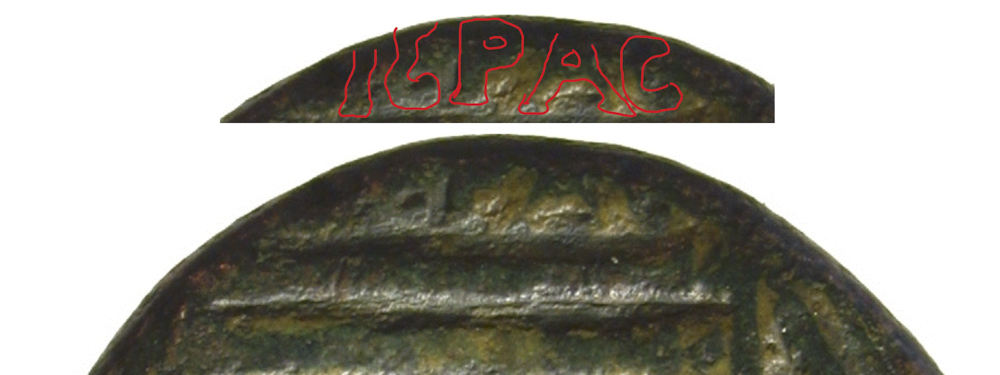Four Notes Regarding Reattribution of some City Coins of Arabia, Galilee and the Decapolis
Abstract:
State of preservation and rarity of some ancient coins sometimes
deceive the researchers who describe them, leading to
attribution to wrong mint or period. Discovery of additional
examples and re analysis of already published coins allowed us
to reattribute three Roman Provincial coin types reported as
minted in Cyrene, Adraa and Tiberias to, respectively, Bostra,
Petra and Epidaurus. Another type of Faustina Junior from Gerasa
was reattributed to Crispina.
Key words:
Ancient Numismatics, Roman Provincials, Tiberias, Bostra, Petra,
Adraa, Epidaurus, Gerasa, Legio III Cyrenaica
Zusammenfassung:
Werden neue Münzen bekannt, besteht die Möglichkeit, Deutungen
und Zuweisungen von seltenen und schlecht erhaltenen Münzen neu
zu hinterfragen und eventuell zu revidieren. In diesem Beitrag
können nun anhand von neuem Material für drei Typen die bisher
angenommenen Prägestätten Kyrene, Adraa und Tiberias zugunsten
von Bostra, Petra und Epidauros korrigiert werden. Ein weiterer
Münztyp lässt sich so statt der Faustina iunior nun Crispina
zuweisen.
Schlagwörter:
Antike Numismatik, kaiserzeitliche Städteprägungen, Tiberias,
Bostra, Petra, Adraa, Epidauros, Gerasa, Legio III Cyrenaica
Note 1: From Cyrene to Bostra
A coin of Faustina
Senior, with head of Zeus Ammon on the reverse[1],
has been known for over a century since it has been published by
Ludvig Müller[2]
who attributed it to Cyrene, which produced multiple issues
depicting Ammon. The only currently known specimen of this type
is from Lindgren collection and is now in the collection of the
American Numismatic Society (fig. 1a)[3].
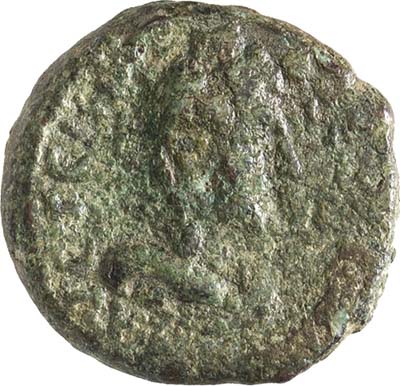
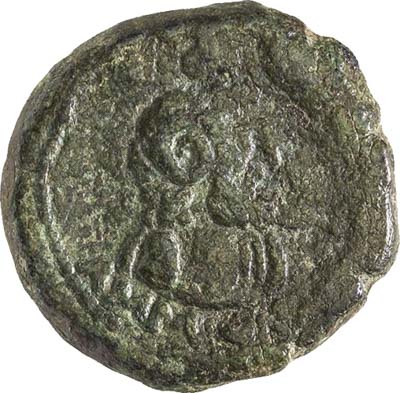
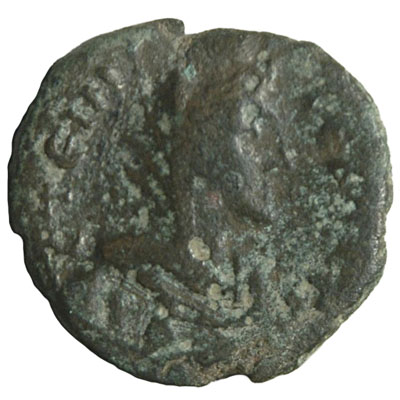
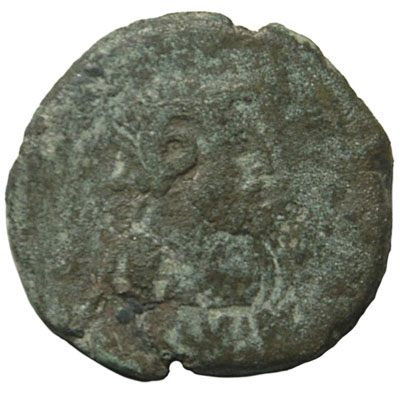
The style of this coin
is very different from other Cyrene issues, and actually very
similar to a coin of Antoninus Pius from Bostra (Arabia),
presumably struck for the Legio III Cyrenaica[4].
Here we report another
example of this type (fig. 1b). Most likely this coin was
struck in Bostra in parallel with the issue in the name of
Antoninus Pius, which has the same reverse type, probably struck
with the same die (fig. 1c)[5].
Moreover, this type shares the obverse die with a published coin
of Faustina depicting Tyche and with the legend BOCTPA on the
reverse (fig. 1d)[6]. Thus, it is now certain that this is a coin of Bostra and not of
Cyrene.
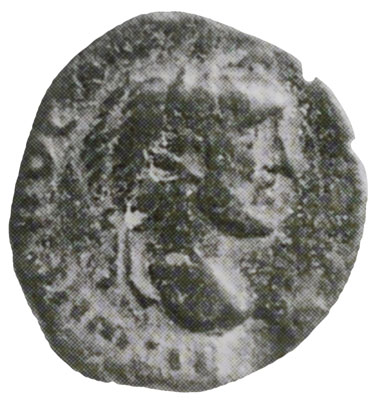
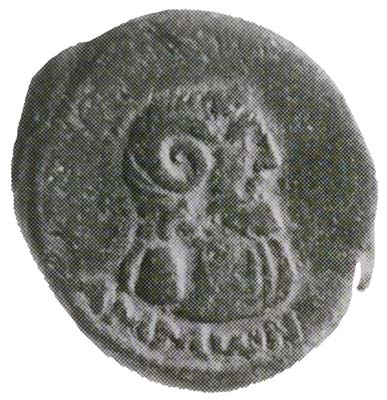
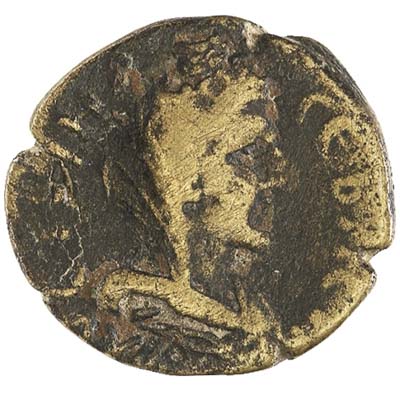
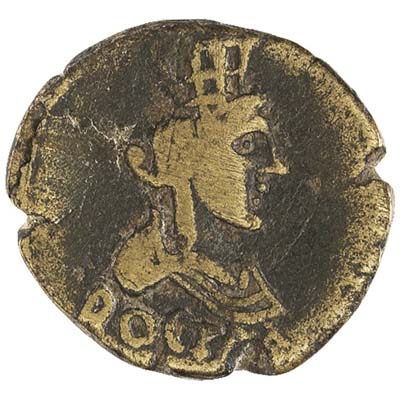
Several posthumous
issues of Faustina Senior were struck in Bostra[7],
all featuring ΘЄΑ
in front of the empress name. In addition, the empress portrait
on the posthumous issues is veiled. The obverse legend of the
coin in fig. 1d (Kindler type 7) is
ΦAVCTЄINA CЄBACT,
suggesting that it is most likely a lifetime issue[8].
This new attribution allows to narrow down the timeframe of the
production of the Zeus-Ammon type to AD 138-140, effectively
brings to conclusion the discussion started by Arie Kindler[9]
who was only able to date the Antoninus Pius/Zeus-Ammon issue to
the reign of Antoninus Pius. All four obverse/reverse
combinations are very scarce, supporting limited emission of
these types likely intended to show connection of Legio III
Cyrenaica with the city of Bostra. Furthermore, Kindler has
suggested that the type of Antoninus Pius/Zeus Ammon, despite
having legends in Greek, is actually a part of Legio III
emission of three denominations. The two bigger denominations
bear Latin inscriptions which allow to date them to the third
consulate of Antoninus Pius, relating to the time period AD 140
to 143. If indeed these coins were struck at the same time, the
date of the Faustina/Zeus-Ammon issue can be further narrowed
down to AD 140.
*
Note 2: From Adraa to Petra
The following type is
not entirely unknown as well. It has been published by
Ya’akov Meshorer et al. as part of the Sofaer Collection
and mistakenly attributed to Adraa[10],
and described as depicting seated Heracles holding club, with
reference to Spijkerman catalogue[11],
indeed depicting Heracles. The state of preservation of the two
coins in the Sofaer Collection does not allow to read the
legends with confidence. Since that publication at least 10
additional coins of this type have surfaced on the numismatic
market: CNG auctions[12],
Shick VCoins[13]
(fig. 2), eBay pharaoh_crypt, and 6 more illustrated
below, most struck with the same pair of dies. Combining visible
details of available coins allows identifying the image on the
reverse as seated Tyche holding a trophy, typical for issues of
Petra[14].
She is holding the trophy with her left hand over her
shoulder. Her empty right hand is stretched forward. The reverse legend is retrograde and mixed
Greek/Latin: PETA CΟΛΝΙΑ.
This issue could coincide with the very common founder type of
Elagabalus[15]
and with significantly scarcer smaller denomination depicting
Tyche seated in a distyle temple[16].
The weight of the latter type is usually between 6.5 and 8
grams, suggesting that the coins without temple (with typical
weight of just over 4 grams) belong to a different denomination
or at least a separate issue, and are not just a variety of the
Tyche in temple type.
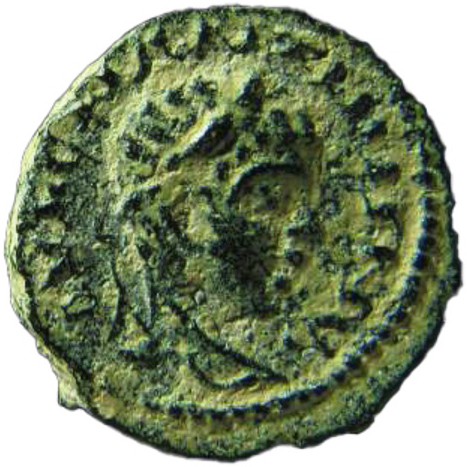
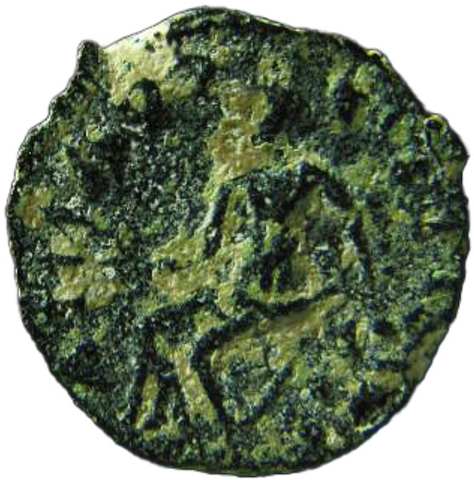
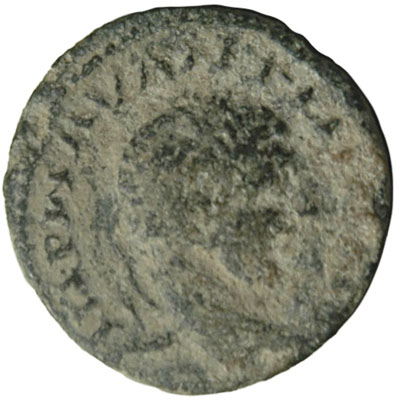
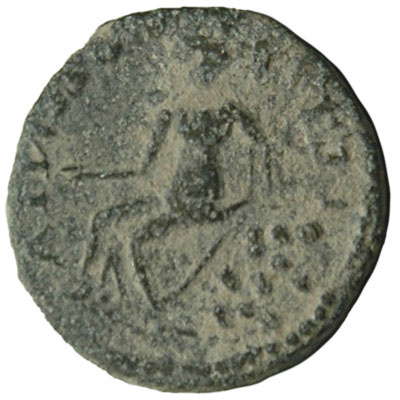
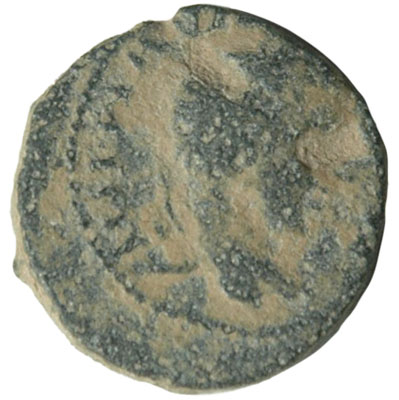
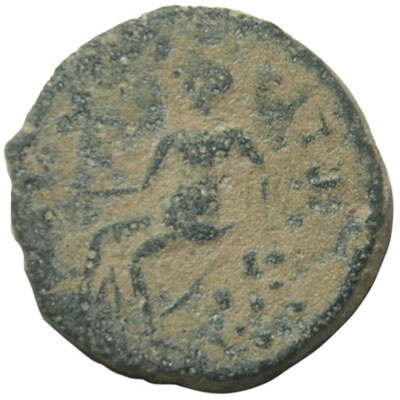
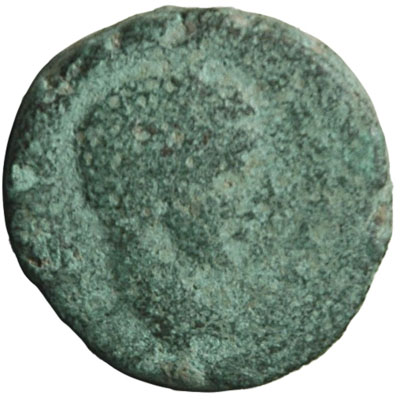
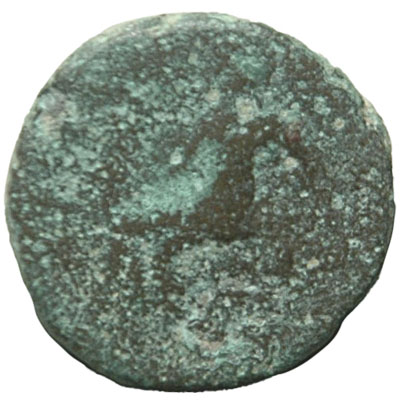
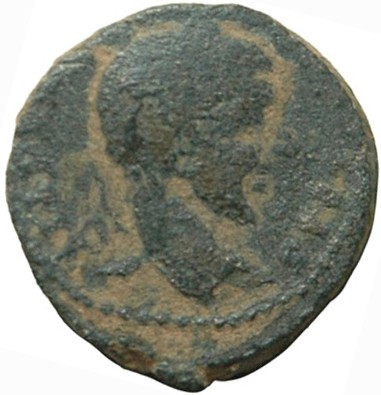
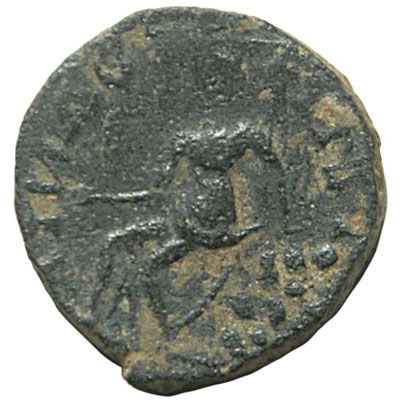
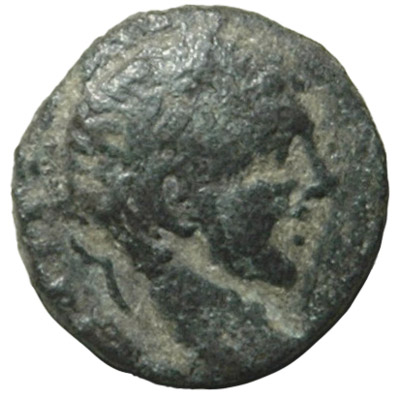
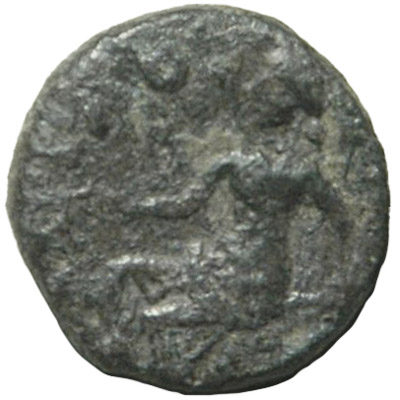
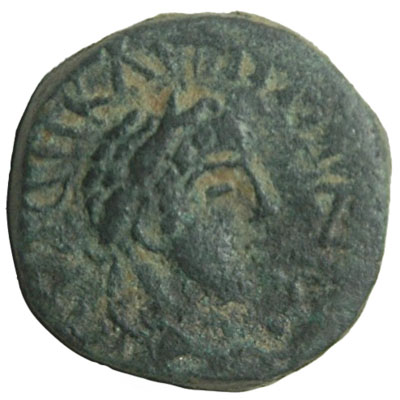
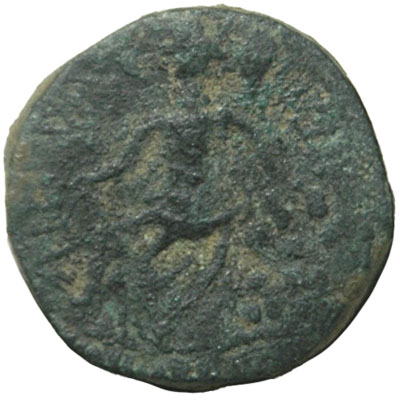
Fig. 8: Coin of
Petra, Obv. Elagabalus, Rev. Seated Tyche holding a
trophy (from private collection). Crude style
The majority of known
coins of the founder type are of degraded style, some to the
extreme degree with completely unreadable legend and very crude
style. Interestingly, two of the coins of the new type (struck
with the same dies, Sofaer collection[17]
and fig. 8) are of ›barbaric‹ style as well.
*
Note 3: From Tiberias to Epidaurus in
Achaea
In the first corpus of
coins of Tiberias[18]
published in 1961, Kindler included a coin from the collection
of Vienna Kunsthistorisches Museum, GR 22478 (fig. 9).
The coin depicts the laureate head of Antoninus Pius on the
obverse and a temple with four columns enclosing a seated statue
of a deity, which Kindler attributed as Zeus, on the reverse.
While the coin is rather worn and corroded, Kindler suggested
reading of the reverse legend as [TIB] CLA. The attribution of
Kindler is commonly accepted[19],
despite the fact that no additional coins of this type have been
identified since Kindler’s original report. Coins of Tiberias
struck after the time of Hadrianus are very rare, with most of
the types represented by less than five specimens, and therefore
the absence of additional examples was not particularly
surprising.
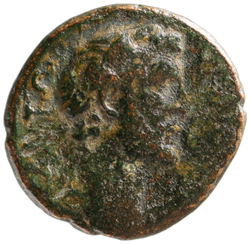
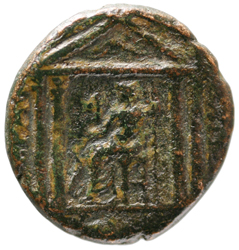
Fig. 9: Coin of Antoninus Pius from the collection of Vienna Kunsthistorisches Museum (GR 22478), © KHM
However, close
examination of the coin published by Kindler allows to suggest
an alternative reading of the inscription. On the left of the
temple one can read ΙЄΡΑC
(fig. 10), which should state for ΙЄΡΑC, ›Holy‹,
or ΙЄΡ(ΑC)
ΑC(VΛOV),
›Holy with the right of Asylum‹. Both readings make attribution
to Tiberias highly unlikely since there is no evidence that this
city carried any of these titles at the time of Antoninus
Pius[20].
Moreover, this reading allows us to identify the
coin published by Kindler as one of Epidaurus in Achaea, RPC
IV.1, 4637 (fig. 11)[21]. Comparison of the two coins reveals that they are clearly
belonging to the same type. This new attribution widens the
period in which coins were not struck in Tiberias to nearly
seven decades, from the emission in the name of Hadrian dated to
the local era AP [101] (AD 119/120) until that of Commodus dated
ΡΞΖ [167] (AD 185/186).
Fig. 10: Reading of the legend on the reverse, left of the temple
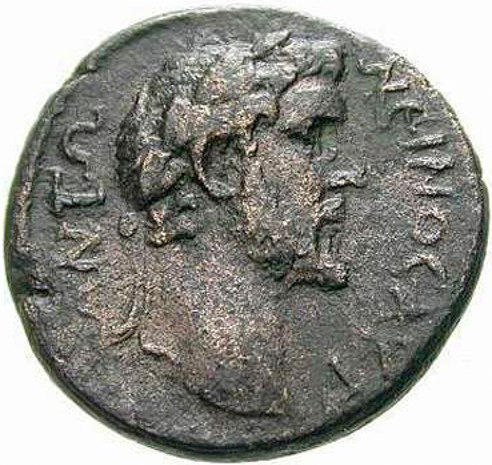
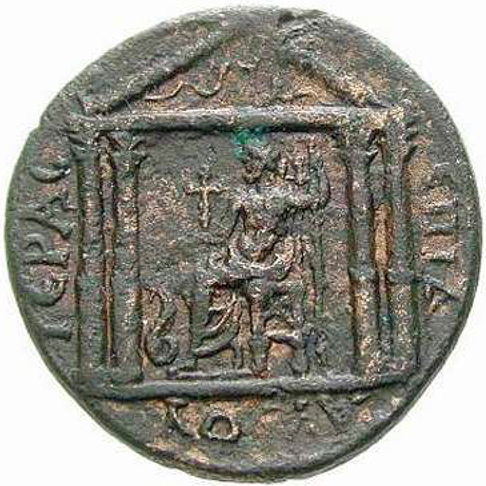
Fig. 11: Coin of Epidaurus, Obv. Antoninus Pius, Rev. Asclepius seated left within tetrastyle temple (Dr. Busso Peus Nachfolger, Auction 378 [2020-04-28] lot 1024)
*
Note 4: From Faustina Junior to Crispina
A coin of Gerasa
attributed to Faustina Junior has been published by Spijkerman
with reference to the Rosenberger collection[22]
(fig. 12). This coin is quite worn and only three last
letters of the eminent name are visible, …INA. Multiple
additional examples of the type have been reported since,
including two in RPC[23]
and few more in trade. The type of draped bust of empress/draped
bust of Artemis has been struck in Gerasa for Lucilla[24],
Crispina[25]
and Julia Domna[26]
and existence of the same type for Faustina Junior would not be
unexpected. However, examination of available images of the
coins attributed to this type reveals that in all of the cases
the name is either worn and could not be read (such as in case
of the coin illustrated by Spijkerman), or it can be clearly
recognized as the well-known type of Crispina[27]
(an example from one of the recent sales is illustrated in
fig. 13)[28]. So far, no specimen that can clearly be attributed to Faustina
Junior has been published or appeared on numismatic market, and
until such example surfaces the type of Faustina Junior/Bust of
Artemis should be either excluded from the corpus of Gerasa
coins or at least marked as questionable.
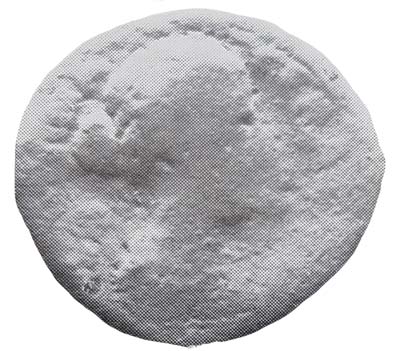
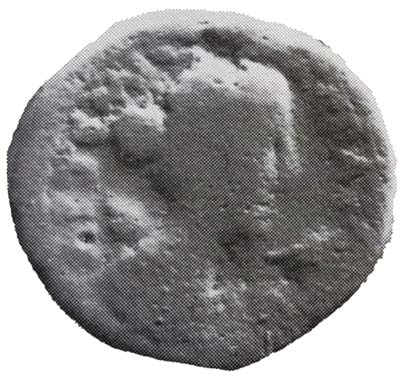
Fig. 12: Coin of Gerasa illustrating type 14 (Faustina Junior) in the book of Spijkerman (Spijkerman 1978 plate 33, type 14)
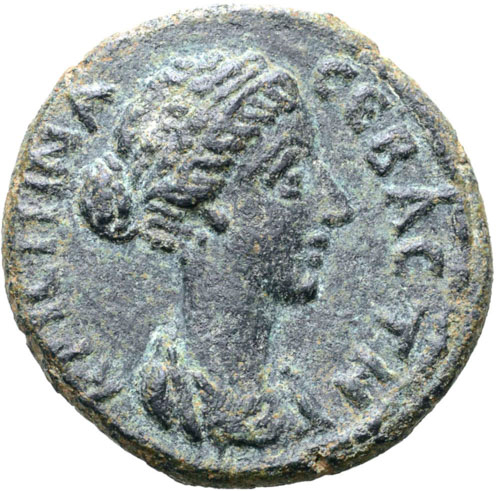
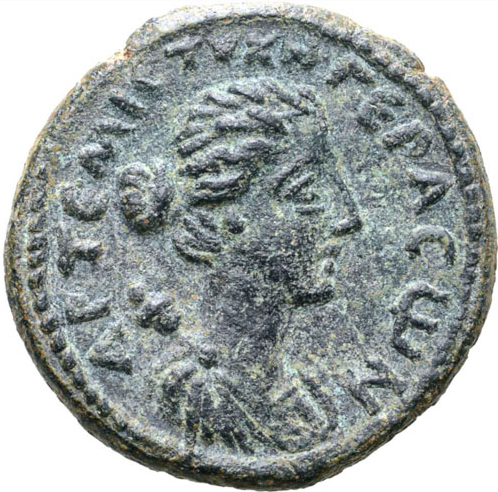
Fig. 13: Coin of Gerasa of Crispina, misattributed as Faustina Junior (Roma Numismatics Ltd., e-sale 52 [2019-01-10], lot 539)
[2]
Müller et al. 1860 Volume I, p. 172, type 449.
[3]
Inv. no. 1998.18.177; previously Lindgren
collection: Lindgren III p. 86, no. 1590.
[4]
Kindler 1983 p. 93, type 21.
[5]
Meshorer 2013 p. 149 Bostra 10.
[6]
New York, American Numismatic Society, inv. no.
1944.100.69247; see Kindler 1983 p. 107, type 7.
[7]
Kindler 1983 pp. 107–108, types 8–11; RPC IV.3 (online)
temp. nos. 6700–6702, 6704–6706, 6365.
[8]
RPC
IV.3 (online) temp. no. 6699
dates c. AD 138-140.
[9] Kindler 1983 pp.
91–94.
[10] Meshorer 2013 p.
145 Adraa 12, 13.
[11] Spijkerman 1978
p. 62 Adraa 13.
[12]
Classical Numismatic Group, Inc., see
https://cngcoins.com/Coin.aspx?CoinID=131599
[13]
https://www.vcoins.com/en/stores/shick_coins/202/product/decapolis_petra_caracalla_198217_ad_seated_tyche/445284/Default.aspx
[14] Lichtenberger
2011.
[15] Spijkerman 1978
p. 236, Petra 56.
[16] Spijkerman 1978
p. 236, Petra 55.
[17]
Meshorer 2013 p. 145 Adraa 13.
[18]
Kindler 1961.
[20] See
Rigsby 1996, who does not list Tiberias under Antonine
asylum-cities.
[22]
Spijkerman 1978 p. 160, type 14; Rosenberger 1978 Gerasa
18.
[24]
Spijkerman 1978 p. 162, type 19;
RPC
IV.3 (online) temp. no 6601.
[25]
Spijkerman 1978 p. 164, type 27;
RPC
IV.3 (online) temp. no 6613.
[26]
Lichtenberger 2003, MZ106.
